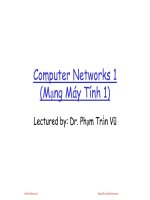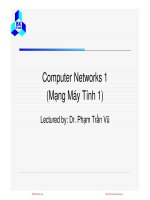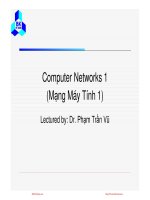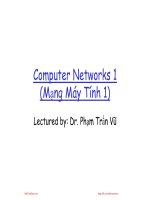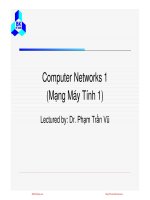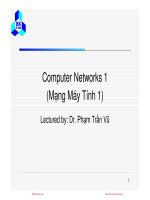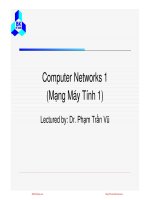mạng máy tính phạm trần vũ bài giảng 1 2 introduction
Bạn đang xem bản rút gọn của tài liệu. Xem và tải ngay bản đầy đủ của tài liệu tại đây (3.08 MB, 88 trang )
Computer Networks 1
(Mạng Máy Tính 1)
Lectured by: Dr. Phạm Trần Vũ
SinhVienZone.com
/>
Course details
Number of credits: 4
Study time allocation per week:
3 lecture hours for theory
2 lecture hours for exercises and lab work
8 hours for self-study
Website:
/>
SinhVienZone.com
/>
2
Course outline (1)
Fundamental concepts in the design and
implementation of computer networks
Protocols, standards and applications
Introduction to network programming.
SinhVienZone.com
/>
3
Course outline (2)
The topics to be covered include:
Introduction to network architecture, OSI and the
TCP/IP reference models.
Network technologies, especially LAN technologies
(Ethernet, wireless networks and Bluetooth).
Issues related to routing and internetworking,
Internet addressing and routing.
Internet transport protocols (UDP and TCP)
Network-programming interface
Application layer protocols and applications such as
DNS, E-mail, and WWW.
SinhVienZone.com
/>
4
References
“Computer Networking: A Top Down Approach “,
5th edition, Jim Kurose, Keith Ross
Addison-Wesley, April 2009.
“Computer
Networks”, Andrew S. Tanenbaum,
4th Edition, Prentice Hall, 2003.
“TCP/IP Protocol Suite”, B. A. Forouzan, Mc
Graw-Hill, 1st ed., 2000.
SinhVienZone.com
/>
5
Assessment
Assignment 20%
Two assignments, 10% each
Midterm exam: 20%
Final exam: 60%
Laboratory work is compulsory
No lab work = No assignment mark
SinhVienZone.com
/>
6
Chapter 1
Introduction
Computer Networking: A Top Down Approach ,
5th edition.
Jim Kurose, Keith Ross
Addison-Wesley, April 2009.
All material copyright 1996-2009
J.F Kurose and K.W. Ross, All Rights Reserved
SinhVienZone.com
Introduction
/>
1-7
Chapter 1: Introduction
Our goal:
get “feel” and
terminology
more depth, detail
later in course
approach:
use Internet as
example
Overview:
what’s the Internet?
what’s a protocol?
network edge; hosts, access
SinhVienZone.com
net, physical media
network core: packet/circuit
switching, Internet structure
performance: loss, delay,
throughput
security
protocol layers, service models
history
Introduction
/>
1-8
Chapter 1: roadmap
1.1 What is the Internet?
1.2 Network edge
end systems, access networks, links
1.3 Network core
circuit switching, packet switching, network structure
1.4 Delay, loss and throughput in packet-switched
networks
1.5 Protocol layers, service models
1.6 Networks under attack: security
1.7 History
SinhVienZone.com
Introduction
/>
1-9
What’s the Internet: “nuts and bolts” view
millions of connected
PC
server
computing devices:
hosts = end systems
running network
apps
communication links
wireless
laptop
cellular
handheld
fiber, copper,
radio, satellite
transmission
rate = bandwidth
routers: forward
packets (chunks of
data)
access
points
wired
links
router
Mobile network
Global ISP
Home network
Regional ISP
SinhVienZone.com
Institutional network
Introduction
/>
1-10
“Cool” internet appliances
Web-enabled toaster +
weather forecaster
IP picture frame
/>
World’s smallest web server
/>
SinhVienZone.com
Internet phones
Introduction
/>
1-11
What’s the Internet: “nuts and bolts” view
protocols control sending,
receiving of msgs
Mobile network
e.g., TCP, IP, HTTP, Skype,
Ethernet
Internet: “network of
networks”
loosely hierarchical
public Internet versus
private intranet
Global ISP
Home network
Regional ISP
Institutional network
Internet standards
RFC: Request for comments
IETF: Internet Engineering
Task Force
SinhVienZone.com
Introduction
/>
1-12
What’s the Internet: a service view
communication
infrastructure enables
distributed applications:
Web, VoIP, email, games,
e-commerce, file sharing
communication services
provided to apps:
reliable data delivery
from source to
destination
“best effort” (unreliable)
data delivery
SinhVienZone.com
Introduction
/>
1-13
What’s a protocol?
human protocols:
“what’s the time?”
“I have a question”
introductions
… specific msgs sent
… specific actions taken
when msgs received,
or other events
SinhVienZone.com
network protocols:
machines rather than
humans
all communication
activity in Internet
governed by protocols
protocols define format,
order of msgs sent and
received among network
entities, and actions
taken on msg
transmission, receipt
Introduction
/>
1-14
What’s a protocol?
a human protocol and a computer network protocol:
Hi
TCP connection
request
Hi
TCP connection
response
Got the
time?
Get />
2:00
<file>
time
Q: Other human protocols?
SinhVienZone.com
Introduction
/>
1-15
Chapter 1: roadmap
1.1 What is the Internet?
1.2 Network edge
end systems, access networks, links
1.3 Network core
circuit switching, packet switching, network structure
1.4 Delay, loss and throughput in packet-switched
networks
1.5 Protocol layers, service models
1.6 Networks under attack: security
1.7 History
SinhVienZone.com
Introduction
/>
1-16
A closer look at network structure:
network edge:
applications and
hosts
access networks,
physical media:
wired, wireless
communication links
network core:
interconnected
routers
network of
networks
SinhVienZone.com
Introduction
/>
1-17
The network edge:
end systems (hosts):
run application programs
e.g. Web, email
at “edge of network”
peer-peer
client/server model
client host requests, receives
service from always-on server
client/server
e.g. Web browser/server;
email client/server
peer-peer model:
minimal (or no) use of
dedicated servers
e.g. Skype, BitTorrent
SinhVienZone.com
Introduction
/>
1-18
Access networks and physical media
Q: How to connect end
systems to edge router?
residential access nets
institutional access
networks (school,
company)
mobile access networks
Keep in mind:
bandwidth (bits per
second) of access
network?
shared or dedicated?
SinhVienZone.com
Introduction
/>
1-19
Dial-up Modem
central
office
home
PC
home
dial-up
modem
telephone
network
Internet
ISP
modem
(e.g., AOL)
Uses existing telephony infrastructure
Home is connected to central office
up to 56Kbps direct access to router (often less)
Can’t surf and phone at same time: not “always on”
SinhVienZone.com
/>
Digital Subscriber Line (DSL)
Existing phone line:
0-4KHz phone; 4-50KHz
upstream data; 50KHz-1MHz
downstream data
home
phone
Internet
DSLAM
telephone
network
splitter
DSL
modem
home
PC
central
office
Also uses existing telephone infrastruture
up to 1 Mbps upstream (today typically < 256 kbps)
up to 8 Mbps downstream (today typically < 1 Mbps)
dedicated physical line to telephone central office
SinhVienZone.com
/>
Residential access: cable modems
Does not use telephone infrastructure
Instead uses cable TV infrastructure
HFC: hybrid fiber coax
asymmetric: up to 30Mbps downstream, 2
Mbps upstream
network of cable and fiber attaches homes to
ISP router
homes share access to router
unlike DSL, which has dedicated access
SinhVienZone.com
Introduction
/>
1-22
Residential access: cable modems
Diagram: />SinhVienZone.com
Introduction
/>
1-23
Cable Network Architecture: Overview
Typically 500 to 5,000 homes
cable headend
cable distribution
network (simplified)
SinhVienZone.com
home
Introduction
/>
1-24
Cable Network Architecture: Overview
server(s)
cable headend
cable distribution
network
SinhVienZone.com
home
Introduction
/>
1-25

